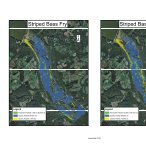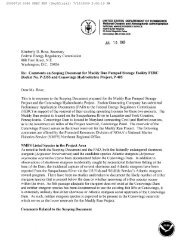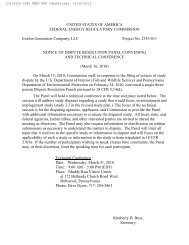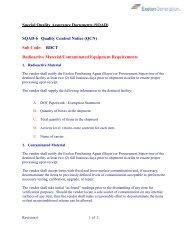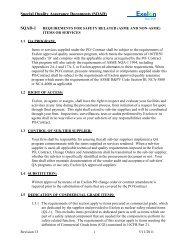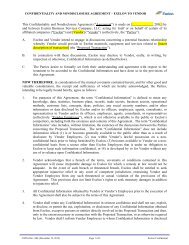Final Report Historical Structures Assessment Report for the Muddy ...
Final Report Historical Structures Assessment Report for the Muddy ...
Final Report Historical Structures Assessment Report for the Muddy ...
You also want an ePaper? Increase the reach of your titles
YUMPU automatically turns print PDFs into web optimized ePapers that Google loves.
Historic <strong>Structures</strong> <strong>Assessment</strong> <strong>Report</strong> <strong>for</strong> <strong>the</strong> <strong>Muddy</strong> Run Pumped Storage Facility Project Relicensing Application<br />
Lancaster and York Counties, Pennsylvania<br />
III. HISTORIC CONTEXT<br />
The Colonial Period: Early European Settlement (1600-1775)<br />
The earliest European exploration of <strong>the</strong> Susquehanna River is attributed to John Smith, who sailed into<br />
<strong>the</strong> mouth of <strong>the</strong> Susquehanna River in 1608, though earlier visits by Spanish Jesuits in <strong>the</strong> late 1500s are<br />
also described in early explorer's accounts. In <strong>the</strong> early 1600s, Edward Palmer established a fur trade post<br />
on an island at <strong>the</strong> head of <strong>the</strong> Chesapeake Bay now called Garrett Island (Preston 1901; Wright 1967), in<br />
Cecil County, Maryland. Early economic pursuits in <strong>the</strong> region during <strong>the</strong> 1600s and <strong>the</strong> first part of <strong>the</strong><br />
1700s were based primarily on tobacco which was transported overland from tobacco plantations to Bay<br />
access points via rolling roads. Shipping points were located on <strong>the</strong> Gunpowder River and <strong>the</strong> Bush<br />
River, <strong>the</strong> latter an early settlement area of <strong>the</strong> late 1600s.<br />
Land at <strong>the</strong> mouth of <strong>the</strong> Susquehanna River was cleared <strong>for</strong> tobacco plantations in <strong>the</strong> second half of <strong>the</strong><br />
seventeenth century. The Project area in sou<strong>the</strong>rn York County, Pennsylvania, an area known as "The<br />
Barrens”, was settled by Scottish and Irish families (Hershner 1977) as well as Catholics from Maryland<br />
(Fortenbaugh 1950; Rupp 1845; Gibson 1886). These early settlements were primarily agricultural with<br />
some residents providing services such as blacksmiths, wheelwrights and o<strong>the</strong>r supporting enterprises.<br />
The economy by <strong>the</strong> early 1700s was focused on wheat production and as wheat farming became more<br />
profitable, mills emerged along with additional supportive trades.<br />
By 1709, German Mennonites were taking advantage of <strong>the</strong> rich agricultural lands in Lancaster County,<br />
Pennsylvania and were soon followed by <strong>the</strong> Huguenots, Scottish, Scotch-Irish, English, Swiss, Quaker,<br />
Irish, and Palatine settlers (Wood 1979). The population was diversified both in terms of ethnic<br />
background as well as job skills and religions which included Mennonites, Methodists, Anabaptists,<br />
Presbyterians, United Brethren and o<strong>the</strong>rs such as Catholics and Jews. Lancaster County was established<br />
in 1729 as an extension of Chester County, from which many of <strong>the</strong> settlers originated. At <strong>the</strong> time it was<br />
first settled, this was considered Pennsylvania’s western frontier and <strong>the</strong> settlements were primarily small<br />
farms with political leadership being dominated by landed and professional people (Loose 1976).<br />
By <strong>the</strong> mid-eighteenth century, single-owner proprietorships were <strong>the</strong> most common. Fur traders on <strong>the</strong><br />
frontier exchanged raw materials <strong>for</strong> manufactured goods in Lancaster. As <strong>the</strong> frontier moved westward,<br />
o<strong>the</strong>r towns including Shippensburg, Carlisle, and York assumed principal trading responsibilities while<br />
local business concentrated on processing and manufacturing (Scull 1760). In 1749 York County was<br />
<strong>for</strong>med from Lancaster County.<br />
Settlers suffered from repeated Indian raids during <strong>the</strong> French and Indian War. The threat of such raids<br />
resulted in a system of frontier <strong>for</strong>tifications and trade supervision. The French and Indian War<br />
stimulated <strong>the</strong> local economy and as hostilities increased, Lancaster became a military center, as well as a<br />
manufacturing and supply station. Hundreds of wagons and pack horses commissioned by Benjamin<br />
Franklin to be used against <strong>the</strong> French invasion of Pennsylvania were obtained in Lancaster (Loose 1976).<br />
Shopkeepers received commissions to supply troops involved in placating <strong>the</strong> frontier, and military<br />
officials requested <strong>the</strong> services of artisans to provide <strong>the</strong>m with manufactured goods. Local gunsmiths<br />
manufactured thousands of guns used during <strong>the</strong> Revolution and several salt works were set up to<br />
manufacture saltpeter.<br />
The development of many of <strong>the</strong> settlements and villages surrounding <strong>the</strong> Project relate directly to <strong>the</strong>ir<br />
proximity to <strong>the</strong> Susquehanna River and its tributaries and creeks. As <strong>the</strong>se areas developed, <strong>the</strong> need <strong>for</strong><br />
various modes of transportation grew as well. The use of roads, ferries, bridges, and canals allowed<br />
residents and businesses to transport <strong>the</strong>ir goods and travel throughout <strong>the</strong> region.<br />
9





